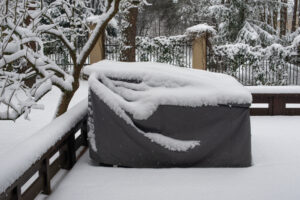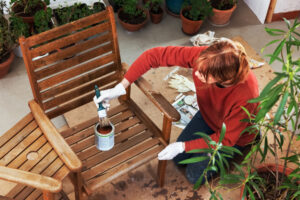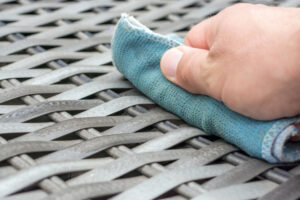How to Store Outdoor Furniture During the Winter
By: Rita Stadler
As the winter season approaches, it is time to start thinking about the proper care and storage of your outdoor furniture and cushions to ensure they remain in excellent condition when spring returns. Leaving them out during harsh weather conditions can ruin your furniture.
One significant concern when storing your outdoor cushions and furniture during the colder months is the potential damage caused by pests that seek shelter in cozy spots. Pests and other concerns like moisture can cause a lot of damage to your furniture which is not what you want to find when the warmer seasons return. In this article, we will share valuable tips and techniques to safeguard your outdoor investments from pests and deterioration during the winter months, allowing you to enjoy them for years to come.
Preparing Patio Furniture for Winter Storage
Before storing your outdoor patio furniture and cushions, it is essential to give them a thorough cleaning. Dirt, grime, and food particles left on the furniture can attract pests, so make sure to remove all debris. Use a gentle soap solution and a soft brush to clean surfaces, and rinse with water afterward. For fabric cushions, follow the manufacturer’s cleaning instructions to maintain their quality. Take care to allow sufficient time for drying to prevent mold and mildew.
This is also the perfect time to inspect your patio furniture for any damage or weak spots and make the appropriate repairs. Check for any loose hardware, tears in the fabric, etc… Also, treat wooden furniture with a protective coating so it looks good as new the next time you are ready to use it!
Selecting a Suitable Storage Space
Selecting the right storage method for your outdoor furniture and cushions is crucial to protecting your valuable investment and preventing pests. Ideally, choose a dry and well-ventilated area, such as a garage, basement, or dedicated storage shed or storage unit.
Elevate the furniture slightly off the ground to prevent any ground-dwelling pests from getting to them. If you lack indoor storage options, consider encasing the cushions with pest-resistant covers specifically designed for outdoor items and using outdoor furniture covers or a waterproof tarp.
How to Properly Store Different Types of Outdoor Furniture
There are specific ways to care for different types of patio furniture based on the material it’s made from.
Metal Furniture (Aluminum and Wrought Iron)
Clean and Dry Thoroughly: Before storing metal furniture, ensure it’s clean and dry to prevent corrosion. Use a mild soap solution and water to clean the surface and let it dry completely.
Apply Protective Coating or Wax: To offer extra protection against moisture and rust, consider applying a protective coating or wax to the metal surfaces.
Disassemble if Possible: If your metal furniture is modular or has removable parts, disassemble it to save space and prevent potential damage during storage.
Store in a Dry, Covered Area: Metal furniture should be stored in a dry, covered area like a garage or shed to shield it from snow and rain.
Wood Furniture
Clean and Dry Thoroughly: Clean wooden furniture with a mild soap solution, and make sure it’s completely dry to avoid mold and mildew growth.
Apply Protective Coating or Sealant: Depending on the type of wood, apply an appropriate protective coating or sealant. For example, teak furniture can benefit from a coat of teak oil.
Disassemble if Possible: Whenever possible, disassemble wooden furniture to prevent warping and damage.
Store in a Dry, Covered Area: Protect your wooden furniture from the elements by storing it in a dry, covered area.
Wicker or Rattan Furniture
Clean and Dry Thoroughly: Use a gentle soap solution to clean wicker or rattan furniture and ensure it is thoroughly dry before storage.
Apply Protective Coating or Sealant: Consider applying a protective coating or sealant suitable for the specific material to prevent moisture absorption.
Use Furniture Covers or Storage Bags: Utilize furniture covers or storage bags to protect rattan or wicker furniture from dust and dirt.
Store in a Dry, Covered Area: Keep the furniture in a dry, covered area to maintain its integrity.
Plastic Furniture
Clean and Dry Thoroughly: Clean plastic furniture using soap and water, and ensure it’s entirely dry before storage.
Remove any Detachable Parts: Remove any detachable parts to prevent them from getting lost or damaged during storage.
Stack or Nest Pieces to Save Space: If your plastic furniture is stackable or nestable, utilize this feature to save space in your storage area.
Store in a Dry, Covered Area: Protect plastic furniture from freezing temperatures, as extreme cold can cause cracks, and direct sunlight, which may cause fading.
Storing Cushions, Fabric, and Umbrellas
Clean and Dry Thoroughly: Before storing cushions, fabric, and umbrellas, clean and dry them completely to avoid mold and mildew.
Use Fabric-Safe Cleaning Solutions: Choose fabric-safe cleaning solutions to avoid damage to your cushions and fabric.
Vacuum or Spot Clean Stains: Vacuum the cushions to remove any debris or dirt, and spot clean stains with appropriate cleaners.
Store in Breathable Storage Bags or Bins: Use breathable storage bags or bins to prevent moisture build-up and potential pest infestations.
Store in an Area That Will Keep Pests Out: Find a storage area that is inaccessible to pests, such as a sealed shed or garage.
Avoid Cushions Getting Chewed and Being Used for Nests: To deter pests, avoid leaving food or other attractive materials near the stored cushions.
Avoid Direct Contact with the Floor: Elevate the cushions and fabric to avoid direct contact with the floor, reducing the risk of moisture absorption.
Avoid Direct Sunlight as it Will Cause Fading: Store cushions and fabric away from direct sunlight to maintain their color and quality.
Storing Grills and Firepits
Clean and Remove Wood: Clean your grill and firepit thoroughly, removing any wood or debris to prevent pests from being attracted to the remnants.
Disconnect Propane: If your grill uses propane, disconnect the tank and store it safely outdoors.
Cover: Use a weather-resistant cover to protect your grill or firepit from the elements during the winter.
Storing Accessories: Store grill accessories, such as brushes and utensils, in a dry, covered area to keep them in good condition.
Preventing Pest Infestations
We recommend integrating natural pest-repelling measures into your storage routine for all types of furniture pieces to deter critters from making them a home.
Clean and Remove Any Food Debris: Food residue attracts pests, so ensure your furniture and storage areas are clean and free of crumbs or spills.
Use Natural Pest Repellents: While it might be tempting to use chemical pesticides to combat pests, it is not advisable for your outdoor furniture and cushions. Pesticides can damage the materials and fabrics and might pose health risks once you bring them back into use in the spring. Stick to natural pest-repelling methods for a safer and more effective approach. Employ naturally smarter pest deterrents like EarthKind products in your storage areas to keep pests at bay.
Seal Any Gaps or Openings: Inspect your storage area for gaps or openings that pests could use to gain entry and seal them off with weather-resistant caulk or tape.
Elevate Furniture off the Ground: Elevating furniture off the ground can help prevent pests from nesting underneath.
Regularly Inspect Stored Furniture: Conduct regular inspections to catch any potential pest infestations early on.
Quick Tips for Buying Outdoor Furniture
When shopping for outdoor furniture, keep the following tips in mind:
- Invest in furniture designed for all-season use to avoid the need for extensive winter storage.
- Opt for weather-resistant materials like aluminum, teak, or plastic that can withstand snow and ice.
- Look for furniture with weather-resistant coatings or treatments for enhanced durability.
Keep Your Furniture Safe During the Off-Season
Proper winter storage is essential to prolong the life of your outdoor furniture and cushions. Regularly inspect and clean your stored furniture to ensure it remains in top condition.
As spring approaches, follow these steps to get your outdoor furniture ready for use:
- Clean and Inspect: Clean and inspect your furniture thoroughly for any damage or wear.
- Replace Damaged or Worn-Out Parts: Replace any damaged or worn-out parts to restore the furniture’s functionality.
- Reassemble and Position Furniture Outdoors: Reassemble your furniture and position it in its designated outdoor space.
- Clean and Air Out Cushions and Fabric: Clean and air out your cushions and fabric before placing them on the furniture.
By taking the time to clean and store your outdoor furniture and cushions properly, along with implementing pest-repelling measures, you can protect your beloved investments from pests during the winter months. A little effort now will go a long way in ensuring your furniture remains in top condition, ready to be enjoyed when the warmer days return. Remember, a well-maintained outdoor living space will not only extend the life of your furniture but also make your next outdoor season even more enjoyable.
For eco-friendly pest prevention and products that help keep your storage areas pest-free, visit EarthKind’s shop online or in a store near you. Protect your outdoor investments with EarthKind’s natural solutions and enjoy a pest-free and worry-free winter season!









 day
day